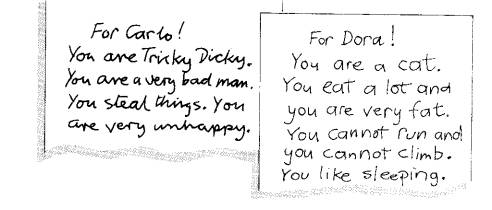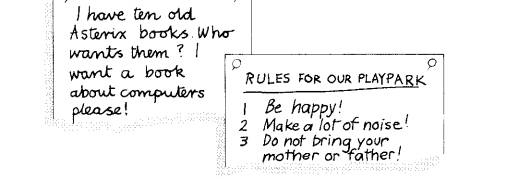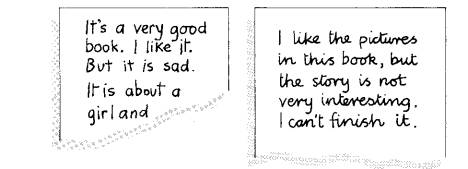. 4. Creative writing activities
Pupils need plenty of opportunities to use language imaginatively. Unlike many older learners, they are always willing to show you their work and to ask 'Can I say this?", so that fewer mistakes occur than might be expected. Let pupils work together in pairs or small
groups wherever possible.
| (a) Writing notes
For this activity, give them tasks that will require longer sequences. For example: |

|
(b) Writing about pictures
Choose pictures that will encourage the pupils to use fantasy and rehearse the idea orally first so that they understand the kind of thing you want. Pupils can also draw pictures for one another to write about.
| (c) Writing rolecards
The pupils can ask someone to be a character from the coursebook or an animal!
|

|
(d) Making up stories
You can start by asking the pupils to write short dialogues, with two speakers, which they should then cut up and give to another group to piece together. Then let them try their hand at very-simple stories
(5-6 sentences), which they should also cut up for another group to piece together.
|
(e) Writing notices You can give the pupils small picture cards for this activity or let them use their own ideas (i.e. they may prefer to write about things they would actually like or things they have). Children very often like
to exchange things so the activity can be authentic. The pupils can also write rules and regulations for their classroom, for example, or for a club or recreation park. |

|
| (f) Writing book reports
When the pupils have reached the stage of using class readers — or even looking through them — they can be asked to write 2-3 sentence 'reports' on them. The reports should he pasted at the hack of the book for other pupils to read |

|
| (g) Writing messages
See 7.3.S (c) for the basic idea. The pupils will happily enter into writing messages from other strange places: the moon, the bottom of the sea, a balloon, the middle of the desert, et |

|
| (h) Project work
One useful and enjoyable project for learners at this age is to get them to make their own picture dictionaries. The pupils can work on their own or in groups (even if they work in groups, so as to help one another, they may like to make their own copy). For the dictionary, they will need an exercise book. They can draw their own pictures or cut suitable ones out of magazines. The intention is not to get them to keep a record of all or even many of the words they have learnt but only to write about items that interest them. They should \\rite sentences about their words (not definitions) and from time to time go back and add to what they have written. |
|
Most pupils also enjoy making a class wallsheet, which will provide a focus for a number of writing activities, e.g. little stories, captions and balloons for pictures, jokes and riddles (etc.). Both the picture dictionary and the wallsheet should be spread over a school year.